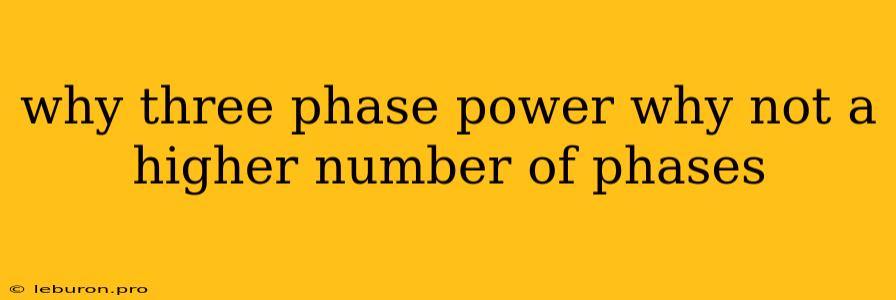In the realm of electrical engineering, the choice of power system configuration plays a pivotal role in ensuring efficient and reliable power delivery. While numerous phases are theoretically possible, three-phase power systems have emerged as the dominant standard for various applications. This dominance can be attributed to a harmonious balance of factors, including cost-effectiveness, power transfer capabilities, and inherent advantages in system performance. This article delves into the rationale behind the widespread adoption of three-phase power and explores the reasons why higher numbers of phases are not generally favored.
The Power of Three Phases: A Comprehensive Explanation
Three-phase power systems utilize three alternating current (AC) waveforms that are shifted by 120 degrees relative to each other. This staggered arrangement creates a rotating magnetic field, enabling the efficient operation of motors and other electrical equipment. Let's dissect the key advantages that have cemented the popularity of three-phase power:
1. Enhanced Power Transfer:
One of the most compelling reasons for the widespread use of three-phase power is its superior power transfer capability. A three-phase system can deliver significantly more power than a single-phase system using the same conductor size. This increased power handling stems from the balanced nature of the three-phase waveforms. The current in each phase is 120 degrees out of phase with the others, resulting in a smooth and continuous power flow. This inherent balance minimizes fluctuations in the total current, enabling the system to transfer more power efficiently.
2. Reduced Current Fluctuations:
Single-phase systems experience a pulsating current that can cause undesirable voltage drops and power losses. In contrast, three-phase systems deliver a more constant current, leading to reduced fluctuations in voltage and a more stable power supply. This stability is crucial for sensitive equipment and applications where consistent power is paramount.
3. Efficient Motor Operation:
Three-phase power is ideally suited for driving electric motors, the workhorses of many industries. Three-phase motors exhibit inherent advantages over single-phase counterparts, including:
- Higher Starting Torque: Three-phase motors can generate a higher starting torque, enabling them to accelerate heavy loads efficiently.
- Smoother Operation: The rotating magnetic field produced by three-phase power ensures smooth and consistent motor operation, minimizing vibrations and noise.
- Higher Efficiency: Three-phase motors typically exhibit higher efficiency than single-phase motors, translating into lower energy consumption and reduced operational costs.
4. Cost-Effectiveness:
While three-phase systems initially appear more complex than single-phase systems, the overall cost benefits often outweigh the added complexity. Three-phase systems typically require less conductor material for a given power rating, leading to reduced installation costs. Additionally, the higher efficiency of three-phase motors translates into lower energy bills, further enhancing the economic advantages of three-phase power.
Why Not Higher Numbers of Phases?
The benefits of three-phase power have led to its widespread adoption, leaving many wondering why higher numbers of phases are not more prevalent. The decision to favor three phases stems from a delicate balance of factors:
1. Diminishing Returns:
As the number of phases increases, the complexity of the system rises proportionally. While additional phases may offer marginal improvements in power transfer or motor performance, the added complexity and cost associated with higher-phase systems often outweigh the potential benefits.
2. Increased Equipment Complexity:
Implementing higher numbers of phases requires more complex equipment, including generators, transformers, and electrical components. The increased complexity necessitates a higher level of expertise for installation, maintenance, and troubleshooting, potentially increasing the overall cost of implementation and operation.
3. Reduced Cost-Effectiveness:
Beyond a certain point, the added complexity of higher-phase systems diminishes the cost-effectiveness of the solution. While additional phases might lead to a small improvement in power delivery, the associated increase in equipment and installation costs can negate the economic advantages.
4. Limited Practicality:
While higher-phase systems might offer theoretical advantages in niche applications, the practicality and widespread adoption of such systems are limited. The current infrastructure, including generators, transformers, and distribution networks, is primarily designed for three-phase operation. Implementing higher-phase systems would require significant investment and adjustments to existing infrastructure, which might not be economically feasible for most applications.
Conclusion:
The dominance of three-phase power in the realm of electrical systems is a testament to its balanced performance. While higher numbers of phases might theoretically offer marginal improvements, the associated complexity, cost, and limited practicality have prevented their widespread adoption. Three-phase power remains the optimal choice for a wide range of applications, striking a harmonious balance between efficiency, cost-effectiveness, and operational reliability. As technology evolves, the landscape of power systems may shift. However, the inherent advantages of three-phase power are likely to maintain its prominent position for the foreseeable future.
